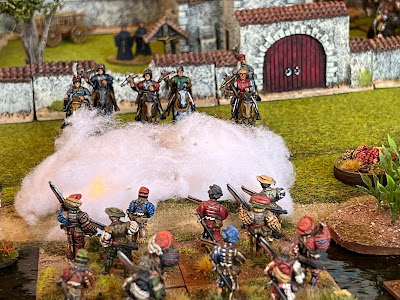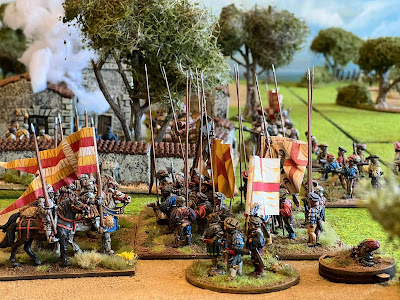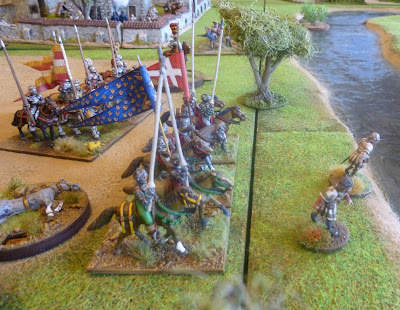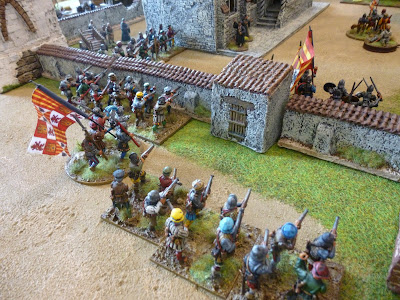For our second game during Stuart's last visit we decided to cover a Tudor campaign that we have not yet explored, the Marquis of Dorset's 1512 expedition to Aquitaine. It's a campaign we have wanted to cover for a while now and we thought it would be interesting to see the English on a more southern European style battlefield as most of their campaigns were in the north. It also allowed us to play a game using loads of figures from Stuart's collection. As his main focus has been the 1513 invasion of France the campaign of the previous year is well covered by his armies.
Dorset's 1512 Campaign
Although the 1513 English invasion of France was the first military campaign Henry VIII took part in personally, it was not the first time he had sent his troops to foreign fields. 1511 had seen Lord Darcy travel to Spain in preparation for a Spanish campaign in North Africa that was being organised by the Spanish King, Henry's father-in-law, Ferdinand of Aragon. The campaign never happened and Darcy's troops fell to drinking and ill discipline. Hall's chronicle describes their behaviour; "The Englishmen which went a lande, fell to drinking of hote wynes and were scarce masters of theim selfes, some ranne to the stewes, some brake hegges, and spoyled orchardes & vyneyardes, and orynges before they were ripe, and did many other outragious dedes". More successful was Sir Edward Poynings who commanded another 1,500 Englishmen to the Low Countries, http://camisado1500s.blogspot.com/2019/04/the-siege-of-venlo-1511.html in support of Margaret of Austria, daughter of Maximilian I, to aid in the war against Guelders.
1512 saw Henry's military ambitions increase considerably with Thomas Grey, Second Marquis of Dorset, leading over 7,000 infantry to Aquitaine, a territory that had been in English hands until the mid 15th Century. The army included a contingent of 500 Landsknecht under Guyot de Heulle, all dressed in white as described by Hall "a gentleman of Flaunders, called Guyot of Guy, came to the kyng with v.C. Almaines all in white, whiche was cutte so small, that it could scarce hold together". They were being sent to assist the Spanish King Ferdinand as part of the Holy League that had been formed by the "Warrior Pope" Julius II against France. The league included Spain, England and the Holy Roman Empire. The English were to recover Aquitaine for Henry whilst aiding Ferdinand, who would provide further troops as well as horses and wagons for the English supplies and artillery in his war against Louis XII of France.
The army landed in Pasaia in the Bay of Biscay in June 1512 and the promised Spanish assistance was slow in arriving. The troops were initially camped between Errenteria and Oiartzun but after complaints of the heat and humidity the English moved closer to the border with France, near Irun which was 40km from the Gascon capital Bayonne. Hall's chronicle describes the move "Then the Lorde capitain remoued his field, and toke another place nerer Fountraby (Fuenterrabía), more plenteous of water and woodde, and there pitched his felde, euery daie lookyng for aide of the kyng of Arragon, but he harde of none". The English proximity to France meant that a threatening mounted force did arrive prompting some of the English to cross the river Bidasoa, at which the French cavalry fled. Hall describes the skirmish on 28 June:
"The Frenchemen of Bayon, hearyng of the Englishemennes campe, made a greate askry betwene the riuer of saint Maria and Bayon: the Englishmen perceiuyng thesame, passed the riuer in good ordre of battail, al being on foote for lacke of the horsemen that the kyng of Arragon promised, and so with arrowes chased the Frenchemen on horsebackes that thei fled, and many horses foundered, and many a man was brosed or thei came to Bayon : at the whiche thenglishmen laughed & lamented. Firste, to see their cowardnes, second, to remembre what thei might haue doen, if thei had had horses mete for their purpose: yet all this notwithstandyng, thei retired to their campe in suche ordre, that the Spanyardes wondered muche, bothe at their fierce corage and sobre ordre."
With no active campaigning the troops were difficult to control. The became prey to disease and drinking with fights breaking out amongst themselves and the locals. A fight between an English Soldier and Basque man in Irun led to the town being looted by the English and landsknecht and the deaths of some of the townspeople.
Following the looting of Irun the French attempted a surprise attack on the disorderly English army but, forewarned by a local Gascon, Dorset was able to ready his troops. He crossed the Bidasoa and forced the French to withdraw. The English pursued the French force, plundering local villages and the town of Saint-Jean-de-Luz that lay between Bayonne and Irun. They reached the walls of Bayonne itself but were forced to withdraw having neither artillery with which to breach the walls or light cavalry that could scour the area and prevent the army from being ambushed or surrounded.
Hall describes the raiding: "Then one daye the Frenchemen whiche hard of this riot and trouble in the hoste, issued out of Bayon toward the Englishe mennes armie, the Englishmen hearing therof, marched toward them, & when the French men perceiued that thei wer asskried, thei sodeinly re- turned. Thenglishemenne perceiuyng that the Frenchemen would not tary, went to a good toune called Sainct Jhon de Luce, and brent, robbed and killed the inhabitauntes, and so from thence spoiled diuerse other villages, aboute the borders of Guyan"
Whilst the English Captains had struggled with their ill disciplined army July 1512 had seen Ferdinand's Spanish forces successfully conquer Navarre. The presence of Dorset's army had meant the French did not cross into Navarre and attempt to stop the invasion and so had been of particular strategic use to Ferdinand of Spain. His emissaries attempted to persuade the English army to winter in Spain so a fresh campaign could begin in the Spring of 1513. This was a plan which Henry back in England supported, stating he would send reinforcements the following year for a new invasion of France.
October saw Dorset fall ill, apparently being so weak that he asked where he was. Command passed to Thomas Howard, later 3rd Duke of Norfolk who would be one of Henry's principal military commanders in the coming decades ( see for example: https://camisado1500s.blogspot.com/2021/06/have-at-wicket-surreys-raid-on-morlaix.html, http://camisado1500s.blogspot.com/2021/07/this-is-like-no-house-of-praier.html and https://camisado1500s.blogspot.com/2021/05/the-english-attack-on-jedburgh.html). With the troops close to mutiny and refusing to spend any longer in Spain Howard organised a return to England. Much depleted by desertion and disease the English army sailed home from the ports of San Sebastian, Fuenterrabía, Errenteria and Getaria. The returning Captains faced a furious Henry and a subsequent investigation into the disastrous campaign. Despite the young King's anger this came to nothing, it seems he was more angry with his duplicitous father-in-law, Ferdinand, than any of his own commanders.
 |
| Dorset's army prepares to cross the Bidasoa. |
Scenario
From the above account it is clear that little in the way of fighting took place during this campaign with the English being used as a distraction by Ferdinand so he could carry out his attack on Navarre. Our options were also limited by the fact the English had no artillery or cavalry in the campaign as these were meant to have been provided by Spain. We decided to base our game on the English facing the French cavalry across the Bidasoa river as this was an event which could have developed into a more serious clash.
With the river zig zagging across the board and counting as difficult terrain and cover the French deployed on one side with the English on the other. Both armies had to deploy in the middle 4ft of the table, 12" from their table edge. The English had to attempt to burn three target buildings (see the photo above) on the French side of the table whilst the French had to attempt to half the strength of the English Army which would force the English to retreat.
Burning the Buildings
To burn one of the 3 target buildings the English had to have at least one base from a unit in contact with it at the start of their activation phase. As an ordered activation, they could use that unit to try to set fire to the objective (instead of Moving, Attacking, or Shooting). If there were 7 or more models in the unit the fire started on a roll of 8+ on 2D6; if there were 6 or fewer models in the unit the fire was started on a roll of 9+ on 2D6.
Ill Discipline
In the encounters with the French in this campaign the English were ill disciplined whilst the French showed an unwillingness to come to blows with the invading army. To represent this each player had twelve cards dealt at the start of the game. At the start of their turn they could decide to play however many picture cards (ie king, queen or jack) they chose from those they had been dealt. Any picture cards played would mean they could move an enemy unit of their choice for that turn. The unit did not need to be activated and the movement would not affect the rest of that players turn but the target unit could not be activated for that players following turn. Units could not be moved off the table using this rule and only movement activations could be made, no shooting or attacking.
The opposing player could use any picture cards they had to counter this. If they decided to do this the player countering the move rolled a D6 and on a 4+ they got to move one of the opposing players units instead. If a 1-3 was rolled the card was spent and the player who originally played a picture card continued to move the target unit.
If a player decided to play 2 picture cards in a turn the opposing player would then have to play 2 to try and counter the moves, rolling a dice for each.
Once players had run out of any picture cards they had been dealt they were not dealt anymore from the deck.
The Armies
For this game Stuart took command of Dorset's English whilst I took command of the French.
Thomas Grey, Second Marquis of Dorset and the English Army
1 Unit of Garrison Bill (Thomas Grey, Second Marquis of Dorset, Retinue Leader)
1 Unit of Foot Knights (Thomas Howard)
2 Units of Shire Bill
2 Units of Garrison Archers
1 Unit of Landsknecht Pike (Guyot de Heulle)
1 Unit of Landsknecht Shot
The French, defenders of Bayonne
2 Units of Gendarmes ( 1 is the Retinue Leader)
2 Units of Men at Arms
2 Units of Ordonnance Archers (with lance)
1 Unit of Mounted Archers
1 Unit of Stradiots
1 Unit of Mounted Crossbowmen
As always the games were played with our renaissance version of Lion Rampant, "Renaissance Rampant". The picture captions are a good way to follow the game but a brief write up also follows below.
 |
| The lighter French horse, in the form of the mounted archers and crossbowmen, advance to defend the church. |
 |
| The English army splash across the Bidasoa. |
 |
| The church is defended by dismounted French archers and mounted crossbowmen. |
 |
| Dorset's men rush across the river. |
 |
| The battlefield as the English draw nearer. |
 |
| As the French heavy cavalry hold back, English bill and landsknecht pike push forward. |
The attack started with the English wading through the waters of the shallow River Bidasoa. The French heavy cavalry looked on but remained stationary whilst the lighter French horse rode forward to take up positions around the church which would be the first target of the English looting and burning. The French archers dismounted to use their bows and the mounted crossbowmen took up a position behind the church walls. They began to shoot at the English but to little effect as Dorset's men were hard to target in the river.
Both armies would demonstrate ill discipline during this clash, the first example of this was seen when the mounted crossbowmen gave up the cover of the church walls riding through the church gates and straight at the advancing landsknecht arquebusiers. The crossbowmen assumed the arquebusiers would be unable to fire at them on account of the landsknecht having just crossed the river. The landsknecht shot had kept their arquebuses and match well out the water and, with their powder dry, they were able to fire a deadly volley into the oncoming mounted crossbowmen. The volley killed enough of the horsemen to send the others in flight from the field.
Now it was the French dismounted archers who came under a rain of arrows from the English archers. The French sent their stradiots and lancers forward in an attempt to dislodge the English who were using the river bank as cover. With both the lancers and stradiots taking casualties the lancers charged the English archers but again the river offered the English protection and the charge faltered at the river bank. In a confused fight in the Bidasoa Dorset's archers defeated the light cavalry. The English assault across the river was looking unstoppable.
 |
| In a moment of ill discipline the French mounted crossbowmen race forward only to face a volley of shot from Guyot de Heulle's landsknecht arquebusiers. The surviving crossbowmen flee the battle. |
 |
| As the mounted crossbowmen have fled mounted lancers and stradiots attempt to hold the French left flank. |
 |
| A group of English men at arms under Thomas Howard reach the church gates. Behind them an unruly gang of English soldiery follows, eager for loot! |
 |
| De Heulle's "Almaines" advance on the French heavy cavalry. |
 |
| The English have crossed the river, sustaining few casualties in the process. |
 |
| The English are into the church yard. Not wanting to engage in a melee with the English the French archers have mounted up and retreated from the attackers. |
 |
| The English soldiery have little respect for the French church... |
 |
| ...and after everything of value is taken, it is set alight to the dismay of the local priests. |
 |
| Having pushed back the French men at arms Guyot de Heulle's landsknecht pike are charged by a unit of gendarmes. |
 |
| Another fierce clash takes place but the German pikemen are broken by the successive waves of heavy cavalry. |
 |
| The battle in full swing with the church already burning and the landsknecht pike about to flee. |
 |
| The French sense that victory may now be within their grasp and the gendarmes, men at arms and lighter lancers launch repeated charges at the advancing English. |
 |
| A unit of English bill is defeated and the disordered survivors flee back across the river to the English camp. |
 |
| The French cavalry have taken casualties but they regroup to prepare for more charges. |
 |
| In the churchyard the Marquis of Dorset is berated by the priest for the actions of his unruly men. This is the only attack Dorset's unit have come under during the advance! |
 |
| A unit of English archers is routed by the French lancers. |
 |
| The French counter attack has not been enough to turn the tide and under a rain of arrows from the archers and shot from the landsknecht the French cavalry are forced to withdraw from the field. |
So a victory for Stuart's English in this game with the English using the shallow waters of the river as a kind of fortification from which to pour forth shot and arrows at the French cavalry. The "Ill Discipline" rule worked really well with Stuart playing it on the mounted crossbowmen, leading to their very quick demise, whilst I used it on two of the English units. It meant they came out of the cover of the river and could be ridden down by the French heavy horse. For a moment I thought this had let me back into the game, adding some real tension to the dice rolls, but it was not to be. It was great to finally cover this 1512 campaign, even if there was far more fighting and drama in our skirmish than actually took place in Dorset's historical one!


































